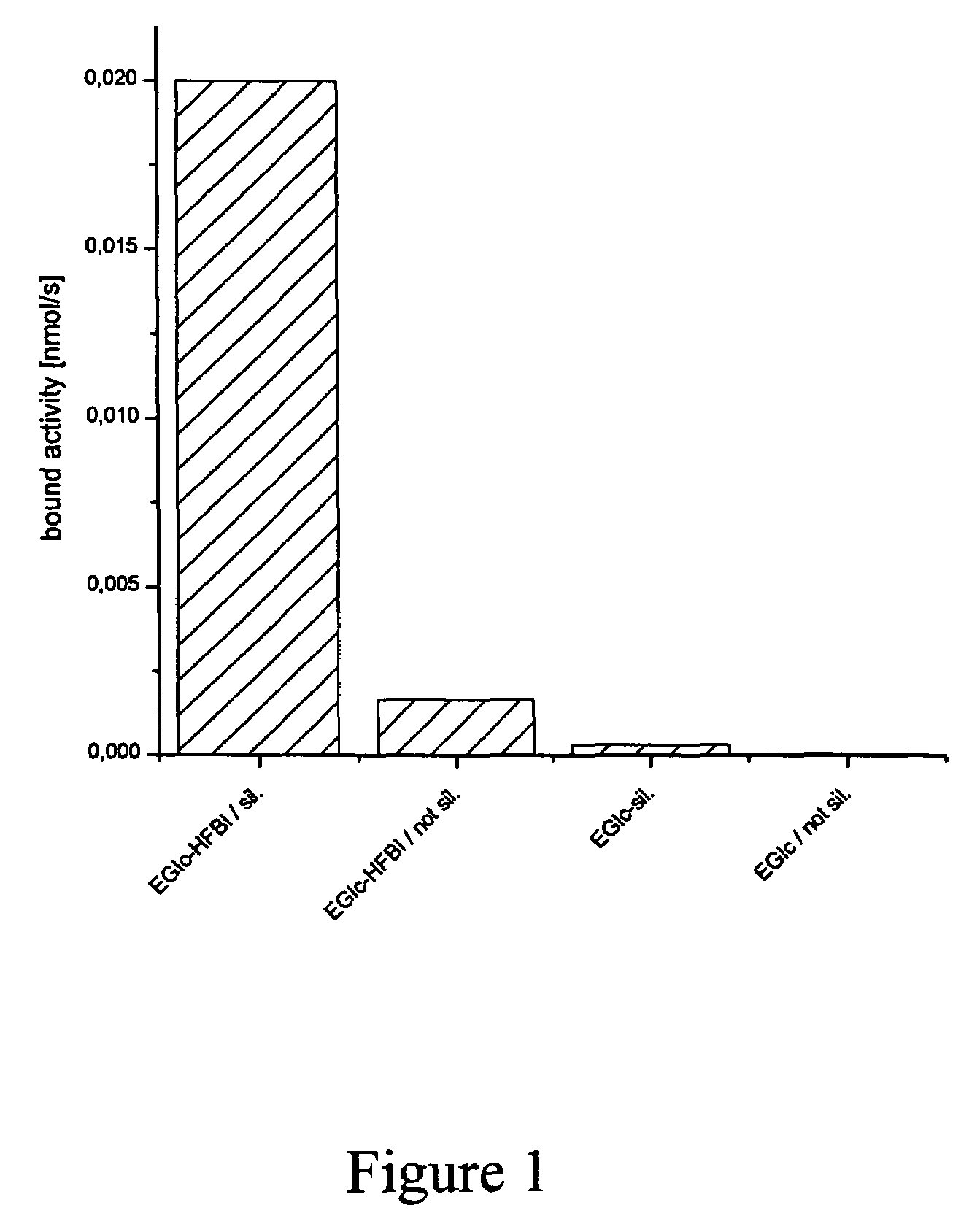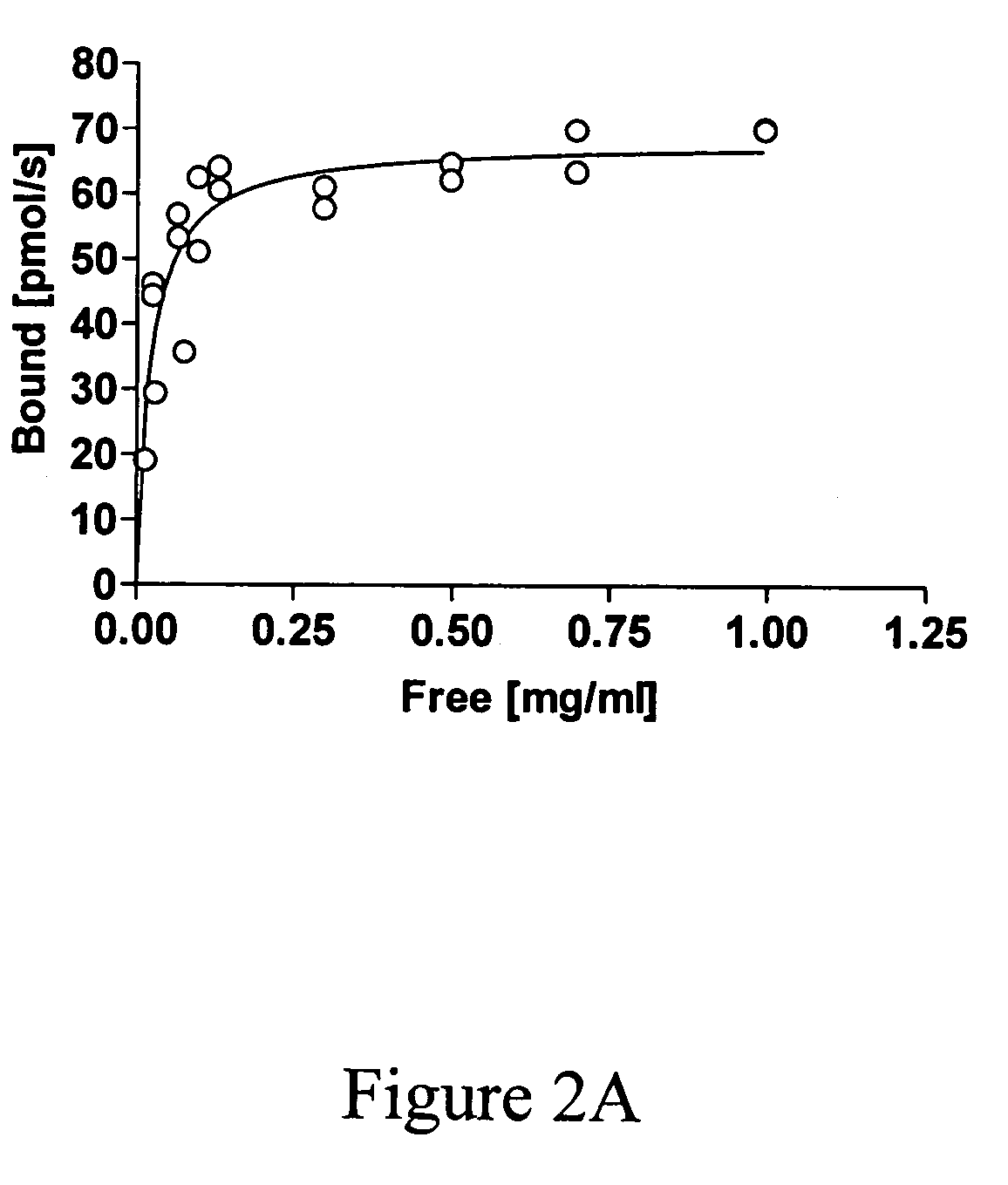Method for immobilization of polypeptides
- Summary
- Abstract
- Description
- Claims
- Application Information
AI Technical Summary
Benefits of technology
Problems solved by technology
Method used
Image
Examples
example 1
Construction of Fusion Proteins
[0072]EGI from T. reesei is, like many cellulolytic enzymes, a modular protein. It consists of a catalytic domain in the N-terminus (368 amino acids) and a cellulose-binding domain in the C-terminus (36 amino acids). The two domains are connected by a glycosylated linker (33 amino acids). The EGIc protein used in this study is truncated form of EGI which lacks the C-terminal cellulose-binding domain and most of the connecting linker. It consists of the first 371 amino acids of EGI. The EGIc-HFBI contains the full linker but at position 403 where the cellulose-binding domain begins, the 75 amino acid HFBI (Nakari-Setala, Aro et al. 1996) was inserted instead of the cellulose-binding domain. Analogously the EGIc-HFBII has the 71 amino acid HFBII (Nakari-Setala, Aro et al. 1997) inserted instead of the cellulose binding-domain.
Recombinant DNA Constructions
[0073]The cloning of EGIc is described in (Srisodsuk, Lehtio et al. 1997), and the cloning of EGIc-HF...
example 2
Protein Production and Purification
[0075]EGIc was produced and purified by ion exchange chromatography as in (Srisodsuk, Lehtio et al. 1997). EGIc-HFBII (strain X77A) was grown in shake flasks in minimal medium (Penttila, Nevalainen et al. 1987) supplemented with 3% Solka floc cellulose (James River Corporation, USA) and 1.5% complex grain based nitrogen source for 7 days. It was purified from the culture medium by first desalting on a Bio-Rad P6 (Bio-Rad, USA) column with 10 mM acetate buffer pH 5.0. The desalted fraction was then loaded on a Resource Q column (Amersham Pharmacia, Sweden) and eluted with a linear gradient of 10 mM acetate pH 5.0 containing 0.2 M NaCl. As a final step the EGIc-HFBII peak fraction was then loaded on a Phenyl Sepharose (Amersham Pharmacia, Sweden) after first adding (NH4)2SO4 to final concentration of 0.5 M. Elution was with 10 mM acetate pH 5.0. The purification was followed by running SDS-PAGE and western blotting using polyclonal antibodies raised ...
example 3
Binding of Fusion Analyzed by Enzymatic Activity of the Polypeptide of Interest
[0078]Binding of EGIc-HFBI and the control EGIc to different surfaces was initially tested by immersing a rod into 0.5 ml of fusion protein solution in a test tube. As standard conditions for adsorption 50 mM acetate buffer at pH 5.0 was used. Addition of NaCl or (NH4)3SO4 was used for testing the effect of ionic strength. For testing the effect of pH, glycine pH 3.0 or Hepes pH 7.0 was used. The rods were either made of glass or TEFLON and had a diameter of 2 mm with rounded tips and a length of about 3 cm. Using the same volume in the test tubes, the exposed surface of the rods was kept constant. The glass rods were either used as such or silanized with trimehylchlorosilane (T4252, Sigma) or dimethyl dichlorosilane (D3879). TEFLON rods were obtained from Cowie Technologies (UK). At certain time-points the rods were lifted out of the solution and placed in 5 ml of 50 mM acetate buffer pH 5.0 for 2 minute...
PUM
| Property | Measurement | Unit |
|---|---|---|
| Temperature | aaaaa | aaaaa |
| Temperature | aaaaa | aaaaa |
| Temperature | aaaaa | aaaaa |
Abstract
Description
Claims
Application Information
 Login to View More
Login to View More - R&D
- Intellectual Property
- Life Sciences
- Materials
- Tech Scout
- Unparalleled Data Quality
- Higher Quality Content
- 60% Fewer Hallucinations
Browse by: Latest US Patents, China's latest patents, Technical Efficacy Thesaurus, Application Domain, Technology Topic, Popular Technical Reports.
© 2025 PatSnap. All rights reserved.Legal|Privacy policy|Modern Slavery Act Transparency Statement|Sitemap|About US| Contact US: help@patsnap.com



